
Youth hold the power to shift the dynamics of the world. If we want change, we must provide leadership support for youth in making change possible. Indigenous youth in particular continue to face racism and discrimination and are marginalized in society, but when they have a sense of belonging and a strong cultural identity they become resilient, powerful individuals. They have immersed roots through their ancestral lineage, wisdom, and intelligence. They are the future leaders for their communities. It is critical to restore leadership from the erosion of their traditional knowledge practices and habitat so that they can begin to create a more sustainable interdependent system for the coming generations.
2018 was a special year for the youth at the UN Permanent Forum because it was the 10-year anniversary of the Global Indigenous Youth Caucus. Youth from around the world had a strong presence as they vocalized and defined what collective rights to lands, territories, and resources meant to them. Every year since the official recognition of the caucus in 2008, there has been an increase of youth participation at the Permanent Forum. The Youth Caucus promotes this participation and is a global platform for youth to collectively address their struggles. It is entirely volunteer based; for the participants there is a deeper sense of responsibility and no other choice but to continue the work of their ancestors. Part of this work is the development of recommendations to the Forum to implement and translate the UN content into a more accessible language for their communities.
From water protectors, land defenders, and biodiversity conservation leadership; to social arts movements, digital media entrepreneurship, and cultural and language preservationists; to Indigenous agriculture and sustainable food systems development, HIV and health awareness, youth suicide prevention, and child and youth sexual exploitation, these are but a few of the issues youth are advocating for. We as a society hold a responsibility to listen to them. At Cultural Survival, we are excited to promote youth voices by launching the Indigenous Youth Community Media Fellowship.
The following are excerpts from panels and interviews with youth conducted by Indigenous Rights Radio producers.
Tuhi Martukaw (Jocelyn Ting-Hui Hung Chien) - Kasavakan Community of the Pinuyumayan Peoples in Taiwan, Youth Caucus Member
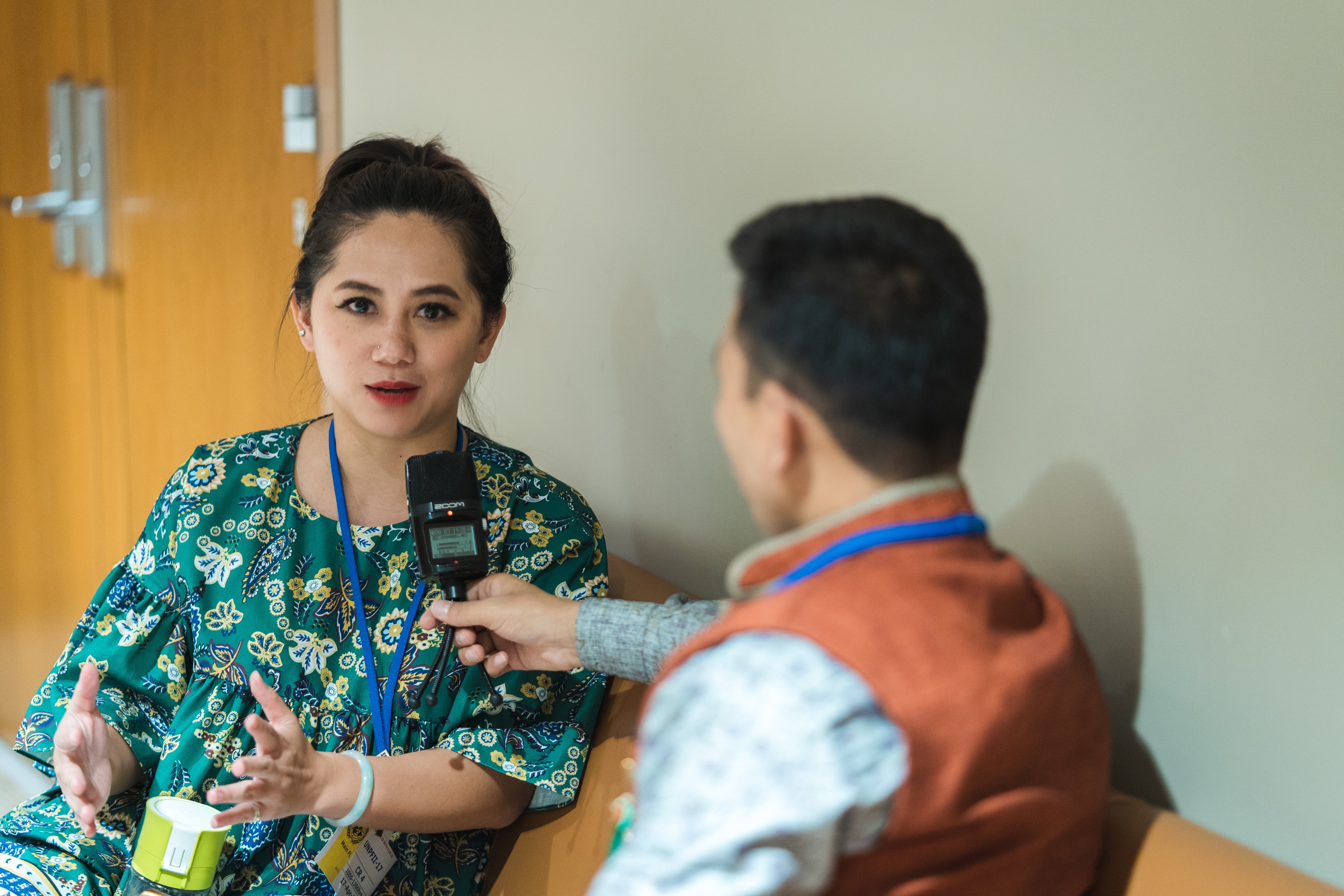
For the 12 years I have been participating at the Forum, I have seen tremendous advancement regarding Indigenous youth participation and spaces for them to speak. It is important for us to be confident. The confidence is based on our knowledge and experiences with our own culture; that is the base from where we can speak up. With that confidence we will be able to negotiate with our elders. We do not have to only be followers, but we can make decisions together. If we are confident enough, we don’t have to be the ones lagging behind.
Since the first session of the Permanent Forum in 2002, there was already a group of youth gathered together trying to negotiate among themselves and to come up with statements with youth positions. In 2006, when I first attended the Permanent Forum, I was asked if I was interested in joining a youth discussion that day. Every year after that I tried to organize the youth, but it was tough. We did not have a conference room, we were not officially recognized as a working group; we were just a group of youth. What we did was just walk around and go to cafes, and if we saw someone who looked young we would invite them to the discussion. In 2008, we were formally recognized as a caucus and it made things much easier. Then we had space and it was easier to get a conference room. It was also easier to attract people to the caucus.
When I first came to the Forum, I was totally shocked. I did not know that this international process regarding Indigenous movements or treaties existed. I also learned the different histories of Indigenous struggles in different countries. I did not even know the history of Indigenous struggle in Taiwan. I wanted to assist people who want to learn about themselves and this international process that I had to learn myself. That’s why I started this, because I did not have this environment when I was younger and I wanted to create an environment where youth can get access to this information.
We have a traditional worldview but we also live in a modern society. We can be creative to utilize social media or other channels to enhance and bring creativity to the movement. Creativity is important because the Indigenous rights movement is not only a matter for Indigenous peoples, but for all human beings. The youth are in a position to walk between different worlds and between societies. We can partner with mainstream society, the media, and all relevant actors. We are also not excluding any possibility to work with governments. If it is something we can cooperate on, we can do it. The important thing is decision making and right to self-determination should be in our hands. We shouldn’t be following rules set by others; we should be the ones to make the calls.
In the past, the mainstream media was not Indigenous people talking for ourselves, but someone else telling our story —and a lot of the time it was incorrect. With community or Indigenous media, we can decide what and how we are going to share and what kind of message we are sending with whatever language we want. For youth, it is a good opportunity for us to train ourselves. Communication is important and with this kind of media we can learn how to express our concerns not only to mainstream society, but to our peers.
Tokata Iron Eyes - Hunkpapa and Oglala Lakota from the United States
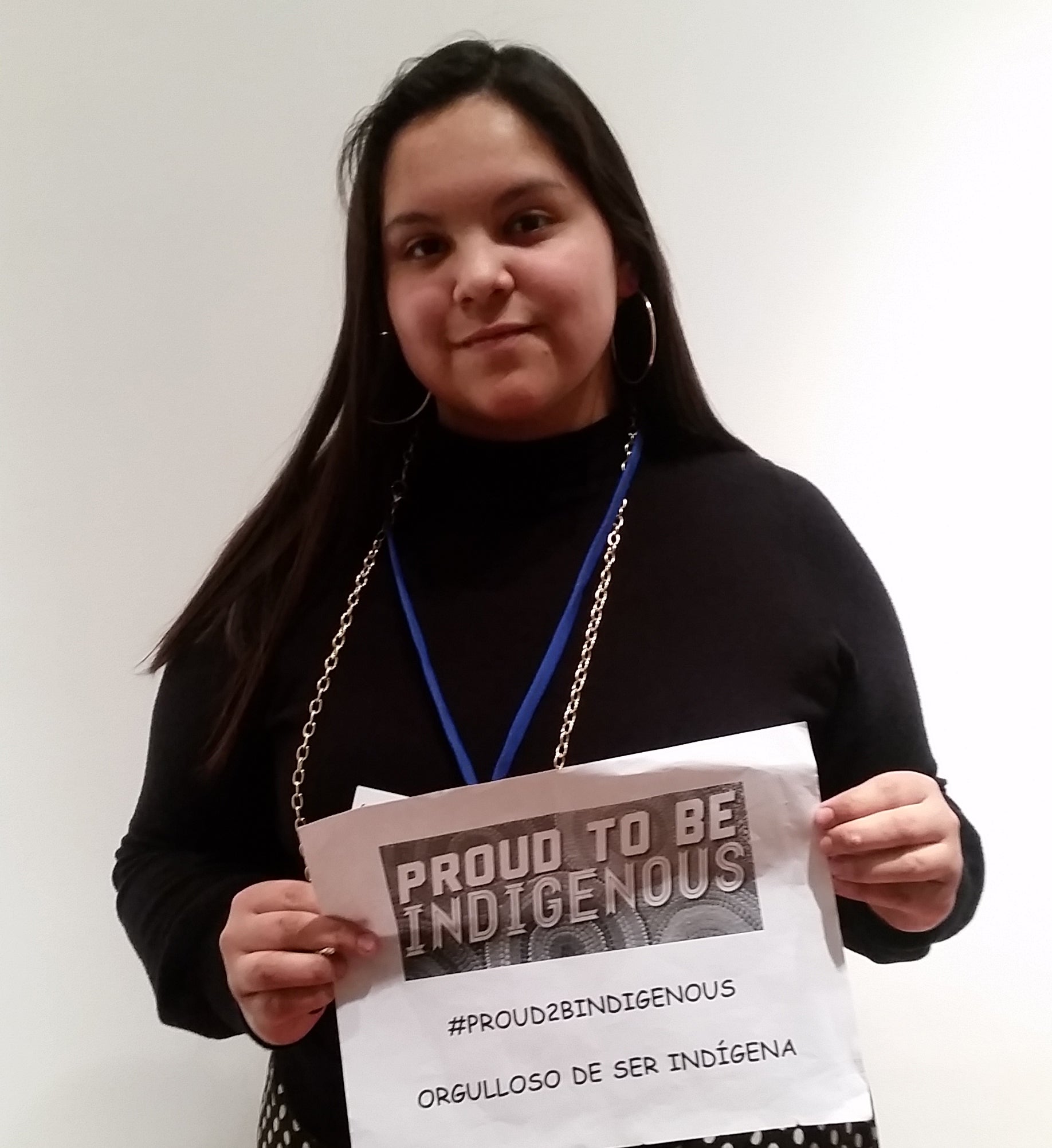
I’m a youth advisor to several different organizations, trying to keep up the momentum that Standing Rock created. In early 2016, I first heard about the Dakota Access Pipeline. It was said to run straight through my home, the Standing Rock Reservation. I just knew I had to do something, and so I just started talking. I look up to my mom so much, and she’s always told me, “as long as you speak your truth, someone’s listening.” I think that’s what gave me the courage really to open my mouth.
During the Standing Rock movement, a huge reason why we got the amount of support that we had was because of the media. In this day and age, media is what can start revolutions. If we’re using it the right way, we can change everything. Sharing works with people. Any issue you see in your community, it’s all about not being scared to share your own opinion. If you know that something’s wrong, if you feel uncomfortable, if you feel within yourself that you need to say something, just say it! Just speak what’s on your mind.
The big thing right now I am working on is missing or murdered Indigenous women. My aunt is Olivia Lone Bear, who’s been missing since October of last year. That really put it into reality for me—that it’s a huge possibility in our communities that I could disappear. It’s scary just to walk out the door. I don’t want my children to have the same fear. I never thought I could be scared like that until one of my relatives was the one who got taken.
A lot of the kids on the reservation especially, they don’t even know their own history. I was lucky enough to have parents who were brought up in my cultural ways, and I was blessed to know those ways and to have that knowledge and wisdom of my ancestors. But, through colonization, a lot of that has been lost. We have a lot of parents who are addicts, who are alcoholics, who are on drugs, and those kids will never know their own history. And it’s not in the textbooks at school. They don’t tell you about the Wounded Knee Massacre, they don’t teach you anything about your grandmother’s grandmother. They’ll never teach you about the brutal and terrifying things; they just don’t talk about the genocide that was committed on our people. There’s a huge identity issue also. Just knowing where you came from is a huge part of finding who you are and who you want to be.
The role of Indigenous youth is to get educated. [It’s] going to school, but also finding out about your own history. I think the role of youth is just to come into that responsibility, to protect the earth, to protect what you have and be thankful for it. As an Indigenous young woman, I’ve known since the day I was born, I was a born protector: protector of this earth, protector of the water. I think that’s a huge thing, acknowledging your own history.
Sefata Uli - Ibaloi Kankanaey from the Philippines
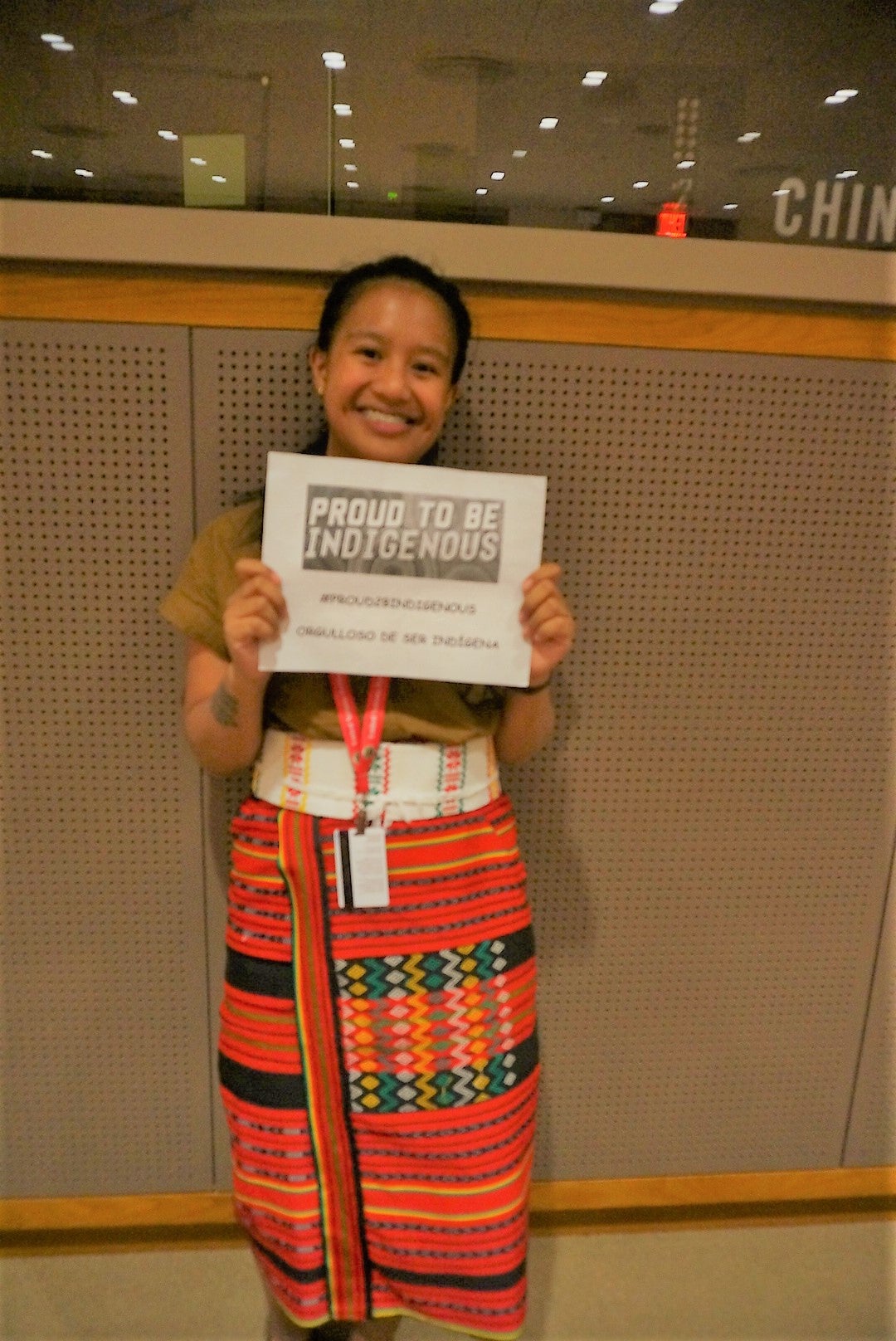
I am an Indigenous Fellow under the Indigenous Leaders Conservation Fellowship of Conservation International, and I’m also on the research committee of the Cordillera People’s Alliance in the Philippines. My parents are also in the same organization, so I was inspired to do a similar kind of work. In my community, in the Cordillera, they have always stood up for their rights as Indigenous Peoples and put up very good resistance against oppressive regimes.
I’m a scientist currently studying wildlife conservation. My areas of interest as a scientist are ethnobiology, and also using traditional knowledge in conservation and seeing how we can integrate traditional knowledge with scientific knowledge to produce outcomes that are culturally appropriate and just for Indigenous communities. I want to spread awareness on what traditional knowledge has to offer in terms of biodiversity conservation. Traditional knowledge shouldn’t be something that you look at as irrational or superstitious. It has scientific basis and traditional practices are often very sustainable. As the inheritors of traditional knowledge, we have the responsibility to carry on this knowledge that we get to future generations as well. It’s what makes our communities resilient.
I think today it’s very appealing to the young generations to leave the community to study abroad or in the cities, and they just leave it at that—they don’t go back to their communities to share whatever they learned, and they stop practicing whatever traditions they have been practicing back home. As Indigenous youth, we should always think back to the community. Even if we leave, we should always consider that going back to the community is something that is important, that our community needs us. They need what we have learned and they need us as well.
So many youth are already educated by modern curriculums or modern education systems. And I think this is something that we can use as well, to integrate with what we know as Indigenous Peoples, to enhance how we live our lives and to keep up with development in the economy. It’s something that will help us keep grounded to what we know as Indigenous Peoples. Community media is definitely very useful in keeping knowledge, in avoiding the situation where knowledge is monopolized by certain people. It also keeps knowledge collectively held in the community, which allows for fair allocation of all the natural resources. Depending on the situation, documentation can be very useful to avoid erosion of the knowledge that we have. It’s important to join the struggle, to make us as Indigenous Peoples recognized by our states, by our countries, and we should always continue the fight for self-determination.
Alejandra Luis - Zapotec from San Pablo, Oaxaca, Mexico

My work began about five years ago when I entered university and was the first generation of young leaders in the state of Oaxaca. There I began to realize the problems that so many young Indigenous people face, especially women. From there I knew that I had to do something to make women’s futures better.
I work in stopping plagiarism of textiles, which occurs a lot in Oaxaca by international companies that go and take advantage of our grandparents’ wisdom. We as young people have many responsibilities, but unfortunately many do not know our rights. Many youth no longer have close contact with our grandparents, with our grandmothers. We are losing this continuity. Yesterday, I heard the Minister of Bolivia say: “We know many of our grandparents and grandmothers, of all the wisdom they bring. But what will our grandchildren say about us?” We have this responsibility. Many young people do not understand and we continue losing wisdom more and more, we keep losing our roles for other issues that we believe are more important. I’m a woman, I’m young, and unfortunately in my town, many people do not believe in me as someone who can achieve. Women are supposed to know how to cook, how to make tortillas, and to get married. It has been quite a challenge to confront [people] and tell them that I am here and no less for being a woman.
We need more spaces where we as youth can raise our voices and offer good strategies. In Mexico, there is no specialized sector for Indigenous youth. We have different aspirations. We know Zapotec, we know different languages. We live eight, ten hours from the city. We do not have access to necessary technology to be in very good communication. Young Indigenous people have so much wisdom, a deep relationship with nature and our ancestors, with Pachamama.
In our town, community radio stations have been started, and an invitation has been made to young people to get involved. I have been invited to start creating a connection. There is no internet in the community. So, how do you know what’s going on in the world, how do you know there are spaces like the Permanent Forum that you can talk to and meet people? In my town, nobody knows the Forum. Not only in my town; nobody knows that there is a place where we can see, express knowing, the situation of other peoples.
We are the future of Mexico. We are the present. We have a great responsibility to get close to our grandparents, our grandmothers, to learn a lot from them. Because as Evo Morales said, “We are in extinction.” Unfortunately, the other cities do not understand that we are children of Pachamama. Because everyone, Indigenous and non-Indigenous, we are brothers and sisters. And if Pachamama disappears, all life disappears. I invite you to learn what you can from those who are still with you. Once they die, this wisdom will be over.
Brayden Sonny White, Ahkwesáhsne Mohawk Nation from the United States
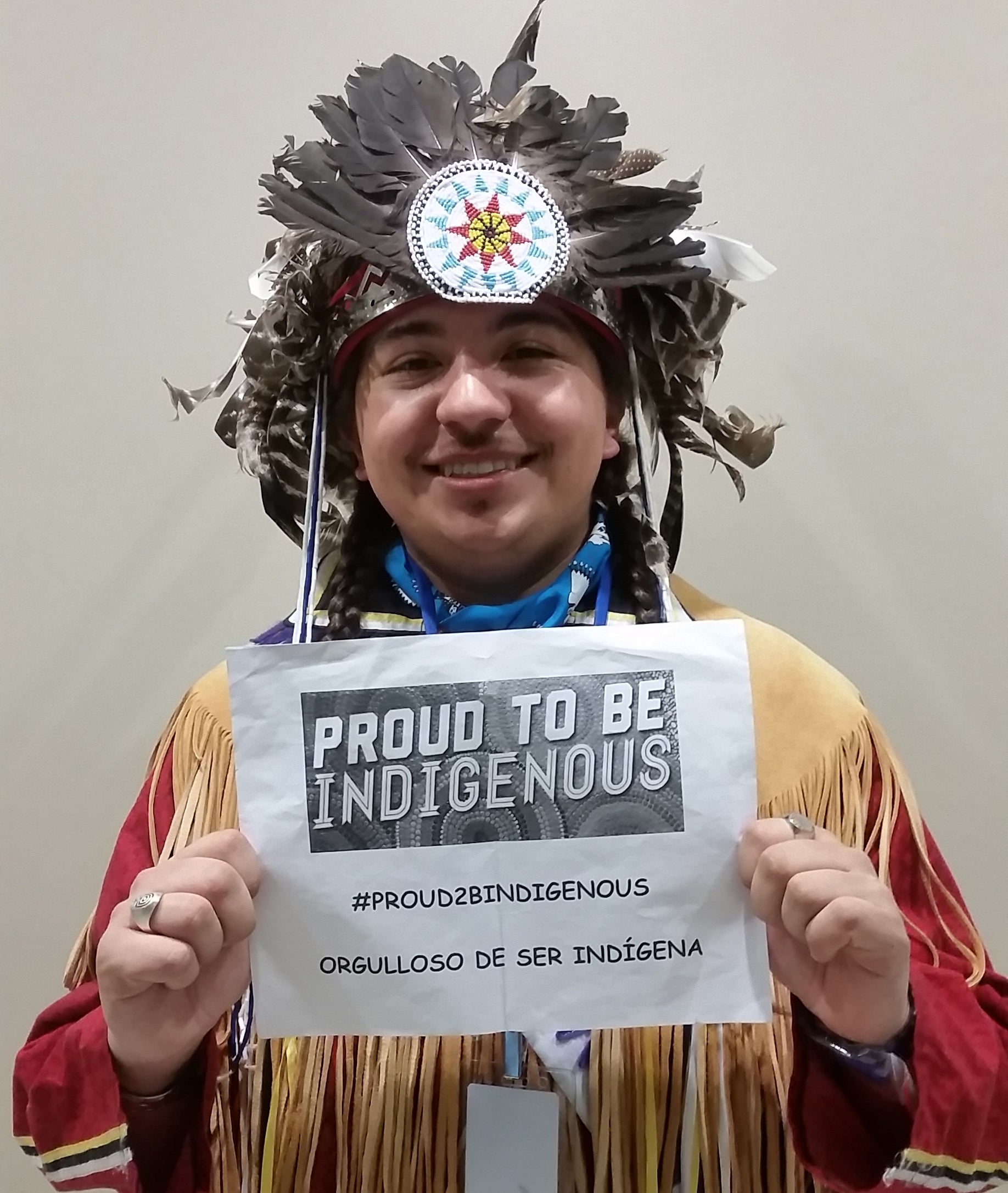
My traditional name means “he carries the bow and arrow upon his back.” I’m currently a legal studies major at SUNY Canton. I’ve always been involved in leadership; it started back in 2015 with the White Hills tribal youth gathering where I got to meet Michelle Obama and I was asked to be a National Native Youth Ambassador. From there I was granted the opportunity to go to the White House Tribal Nations Conference in Washington, D.C., where I was asked to speak on a panel with President Obama as a Gen-I National Native Youth Network Ambassador. I spoke on how to get Native American First Nations youth to be able to attend college with financial difficulties, as well as suicide prevention [and] how we can curb that epidemic.
From that I got involved with the Center for Native American Youth Champions for Change program. I really enjoyed my time there and I still I work with them currently. I got to work with United National Tribal Youth as a “25 under 25” award recipient. Then to come to the UN was so amazing. That started last year when we had an event for the 40th anniversary of the United Nations Declaration on the Rights of Indigenous Peoples; with that I got to meet with elder Kenneth Deer, who currently works with the UN.
In my community, I help with roadside cleanup and the environmental division. I am also a SAFE talk facilitator (Suicide Awareness For Everyone). A big thing for me is to get people aware of the signs of suicide and someone in crisis. Personally I’ve lost someone, one of my close friends, in 2012 to suicide. Suicide is something that can affect anyone from any nationality, any gender, any financial background.
A big thing youth are struggling with is in the higher education sector, because to get a job you need a degree. Youth are struggling with culture shock and drug and alcohol problems. In my community, it’s very easy to get drugs and alcohol. That’s very hard to see. I’ve never touched drugs or alcohol; you can be the first to break that cycle. Look at the things I’ve been able to achieve—I’ve been able to speak with President Obama and meet Prime Minister Justin Trudeau and Michelle Obama.
The youth always inspire me and I’m always there like a big brother showing them a path. A big inspiration is hearing from elders and parents who tell me that they want their children to be like me, making that impact in the community. I want all youth to have these opportunities and be able to spread their wings. If you had told me five years ago, being a rez kid from a low income family, that I would have the opportunity to meet a prime minister and a first lady, I would have laughed. My passion is what drove me to continue my work. I tell youth that brick by brick, you can get there.
Indira Vargas - Kichwa from Ecuador (left)
I am part of CONIAE (Confederation of Indigenous Nationalities of Ecuador). I am here participating in a global school organized by FIMI (International Forum for Indigenous Women) while at the Permanent Forum on Indigenous Issues. Nature has inspired me. It inspires me to be an equal woman. We can walk, we can choose the path we want.
At CONIAE we are promoting youth involvement with political participation, leadership, and also strengthening communication. This work is making our territory visible. Governments, those in charge who represent us, they do not listen to us. Our goal is to communicate to our bases via true communication. Because we know that the mainstream sectors do not reach our territories, it is important to communicate all the experiences of our communities: what is happening in the territory, about meeting of leaders of the community, what the struggles are. And also promoting the voice of Indigenous women, the work, the roles, what are their concerns, what is needed. Through the women’s march, a group was born. We call ourselves “lanceros digitales” (digital lancers). We have taken this symbol of the struggle, a very sacred symbol that is the lance, the lance that our grandparents used. We throw it and believe it will reach people in this digital way. Why digital? Because we see young people have been empowered by social networks such as Facebook, Twitter, Instagram, and other websites.
We do not see results of our demands. We are in this space, but the States do not hear us. We are worried. As a generation, it is important to see, to know the words that our grandparents and grandmothers placed here and what they have built. We have to continue this struggle and follow this collective organizational process. We are very interested in influencing these spaces. We, young people, are capable. Sometimes they distrust us because we are young. But we are the future; who else is going to give these messages to new generations? What elders are doing with us, we then will pass the messages of identity, culture, language, collective rights, our communities, the life of the jungle, the connection with the Earth, forward.
In Ecuador we are fighting for free access to higher education so that more Indigenous youth and women can influence these spaces. In the public sector it is very difficult to access scholarships. There are many other organizations that are promoting young Indigenous people to access scholarships. Do not be discouraged, continue learning, do not forget the principles of our communities and institutions. Do not forget that we come from a resistance of our peoples. We have to empower the spaces that we can occupy. Do not forget who you are. We come from a community, we come from the ailu, (family). We come from a broad family full of knowledge.
Lithia Philips - Omaha Tribe of Nebraska from the United States
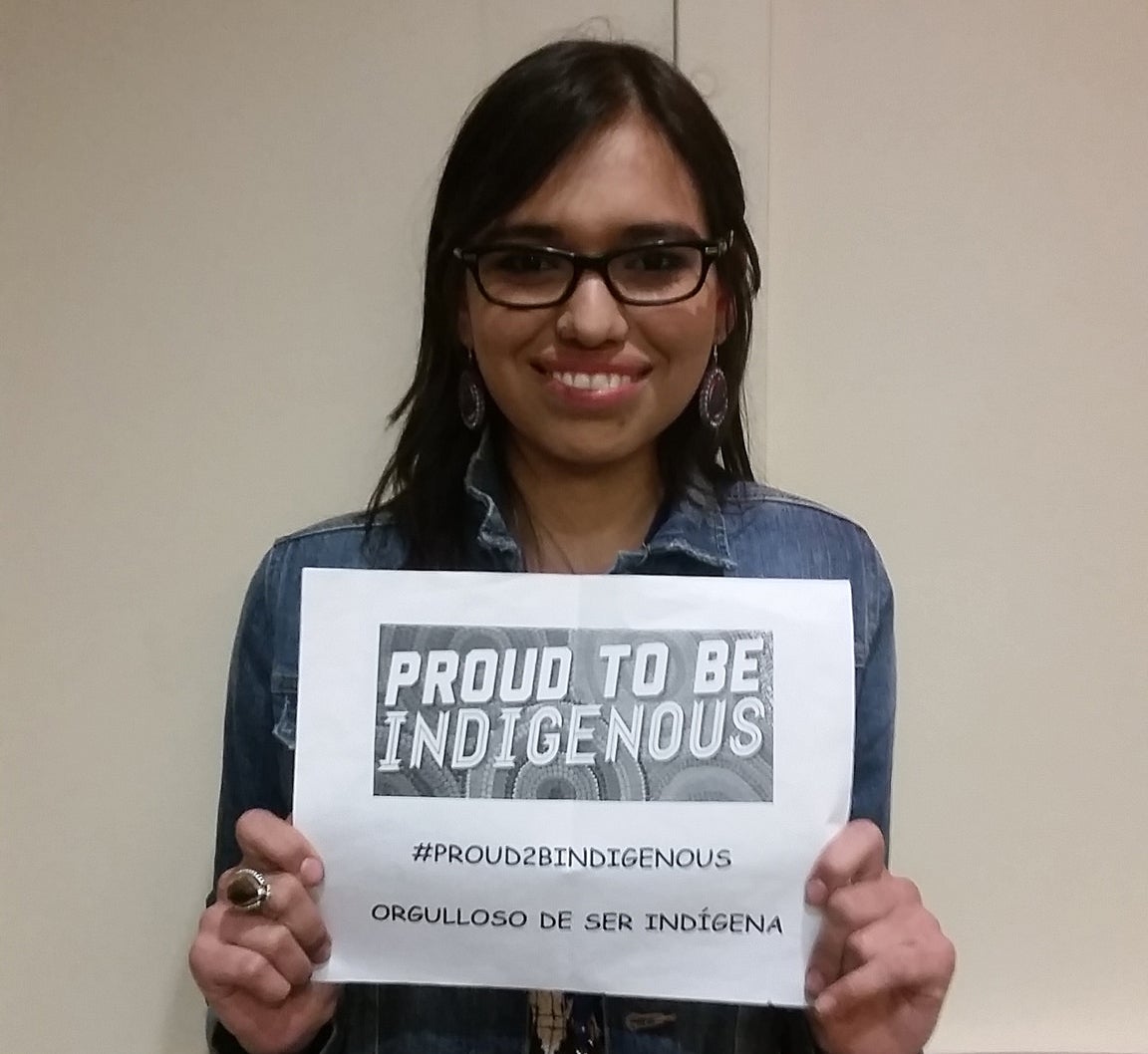
I only planned to be in Standing Rock for two weeks, but when I got there and it was time to leave, I told my dad I couldn’t leave and so we stayed until camp was evicted. I got shot at, I got tear gassed in the middle of a prayer song, I got maced. Being at Standing Rock and learning about extractive industries and the pipelines going through sacred burial land and what we are doing here as Indigenous Peoples being caretakers of the land . . . the clean water and clean air, these things do not belong to us, these are meant to be here for future generations. I am here at the United Nations to speak on behalf of the youth, to speak for the seventh generation. This is not only about our children now, but for generations ahead. I want to make sure that the Indigenous youth have a voice in this conversation, that we are taking action to try to change the consciousness of the people and the governments that are representing us.
Standing Rock started as a youth-led movement unifying Indigenous people from all over the world to stand up and say our governments have not been representing us, they have not been protecting us, they have not been responsible, they have broken their treaties and their promises. We need to reclaim our languages, reclaim our culture, and say this is who we are and that we have a right to exist as we are. Getting youth involved in leadership and culture is really part of what we as Indigenous people need to do for our youth and elders to stay true to our identities.
I work with the Native Youth Alliance. Since Standing Rock we have been traveling to show that the movement is not over. The camps may no longer be there, but what has happened—the unification of Indigenous people—isn’t going anywhere. Extraction industries are in everyone’s backyard all over the world. So moving forward, we would like to unify the Indigenous youth, learn about direct action, and continue to make the planet a better place.
Giving youth a space to voice their concerns and ideas, their creativity and culture, and empowering youth through mentorship...being able to tell our own stories is a big part of that. Media is a huge part of people’s fight for rights. At Standing Rock, people were watching from all over the world. There are videos of what happened at Standing Rock, of the frontlines. We have to tell our own stories, we have to be the ones to create our own narrative. We as Indigenous youth need to break the cycle of what has happened in the past, break the cycle of the genocide. Go back to your roots. Go back to your culture. Go back to your ceremonies, go back to your language. Know that there is power in your identity, there is power in your ancestors.
All photos by Nati Garcia and Jamie Malcolm-Brown.
Main Image: Indigenous youth show their pride at the 17th session of the UN Permanent Forum on Indigenous Issues in April.
